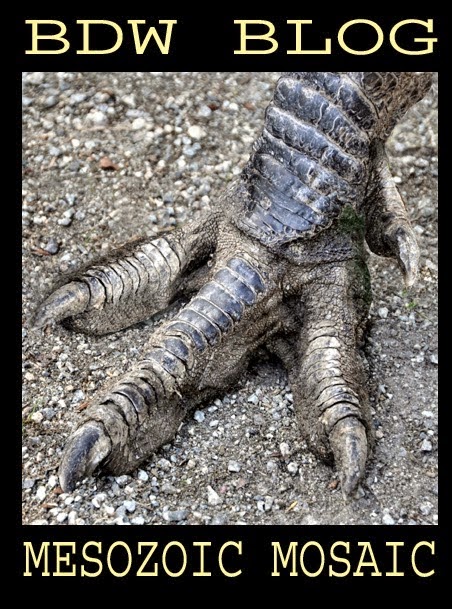I have discovered this particular Early Cretaceous sauropod track site a few years ago.Last weekend I went to take a few more photographs. The light was favourable, that late Friday afternoon, so I made some interesting new discoveries. It seems that a rather large theropod walked at the same site. Maybe a bit earlier than the sauropod, because the footprint on the left is a bit deformed by the print that sauropod left later. There was another theropod on the right, or maybe this time theropod returned to stalk the sauropod.
In fact, there should be a right manus sauropod print roughly at the same place where the theropod left pes imprint is. Thus, it seems that the theropod stepped over it, obliterating it. It's possible the large theropod was following the sauropod!
There is at least a dozen different spots with sauropod tracks or dinoturbations near the city of Pula. I need to draw a map, because it is becoming ever harder to keep all those places, including the tracks of other tetrapods, in my mind.
My interpretation is on the right. The length of the theropod foot was in the range of 55 and 60 cm. The animal was probably at least 10 to 12 metres long.
TLP = theropod left pes; SRP = sauropod right pes; SRM = sauropod right manus
The ripple marks on a layer that is about 30 cm above the sauropod track site layer.
Ankylosaur tracks that are a few kilometres further along the coast.
The sea was very calm that day.
I must admit I am completely lost here: What made these round prints in a shallow sea water some 100 mya? A medusa? Some fish? (A ray fish feeding)?
My interpretation - which led me to no conculsion. Of course, it's not the only round imprint of the same kind there but this one is the largest.
Pula the other day: a mummified carcass of a seagull washed out on a beach. It gives you an idea why are many fossils so jumbled.
A giant Iggy track-natural cast, I have found years ago. This one has its toes well defined. It is probably the right foot imprint.
The Iggy track - natural cast, I have found a few months ago. If you have any "objections" over its size, I can only tell you that I have found quite a few of the tracks of similar proportions and a couple of prints that are even larger!
Pula last weekend: Opa! It seems I have found some small pterosaur tracks, again. It might the left foot (pes) in the centre. The other prints are less preserved. I am quite certain that the left foot on the right belongs to me, though.
Tuesday, 12 May 2015
Tuesday, 14 April 2015
Tracks, tracks again
A mid-Cretaceous layer from the Solaris outcrop, with mud cracks and a possible dinosaur track. The ripple marks on a lower layer. I was standing on the rock that was about 80 cm above the layer with the mud cracks.
A possible sauropod track with my interpretative outline (Albian near Pula)
A probable sauropod track
A pebbly beach, Pula.
Some parallel sauropod trackways near Pula.
Recent dog tracks showing varieties in preservation.
Lovrečica: a damaged theropod trackway. A buldozer went over them during some construction works.
Lovrečica: a theropod track.
Some unusual traces from a Pula beach.
Sauropod tracks near Pula.
Theropod tracks (Pula)
Cliffs (Pula)
Rudists (Pula)
A beach in Pula
Monday, 30 March 2015
New tracks
Yesterday afternoon, I was walking along the outcrop near Pula, that I had visited only once before while searching for tracks. This time I had a bit more luck. I have found a couple of large theropod footprints in a straight line, but not as a complete sequence. The third, middle footprint was missing because it was covered with the rock layers. Although the state of preservation is rather poor, it seems both prints are from the left foot and the missing one is the right foot. The animal was walking fast with a rather long gait. The length of the footprint is about 45 cm.
The last image above is my interpretative footprint outline.
The outcrop has some interesting geological features. Gypsum crystals are quite abundant.
Here is another track site (probably sauropods) about a 100 meters further down the beach.
Gypsum crystals are abundant and are glittering in the sun.
Many of the rocks are broken in a way as if they have been cut by a man. Which, of course, is not the case here.
The last image above is my interpretative footprint outline.
The outcrop has some interesting geological features. Gypsum crystals are quite abundant.
Here is another track site (probably sauropods) about a 100 meters further down the beach.
Gypsum crystals are abundant and are glittering in the sun.
Many of the rocks are broken in a way as if they have been cut by a man. Which, of course, is not the case here.
Thursday, 26 February 2015
Saturday, 7 February 2015
Good old Triceratops
Triceratops is certainly among the most popular dinosaurs. Here is my restoration from 1990/91:
... and here is my latest restoration (January 2015) of a juvenile specimen:
One of the ceratopsians with very distinguished bone frill was Pentaceratops (my restoration from 1990)
Torosaurus with young (2001). There are some theories claiming that Torosaurus is in fact an ontogeny stage of Triceratops.
The main predator feeding on Triceratops was Tyrannosaurus rex (1993)
Subscribe to:
Posts (Atom)









.jpg)









































